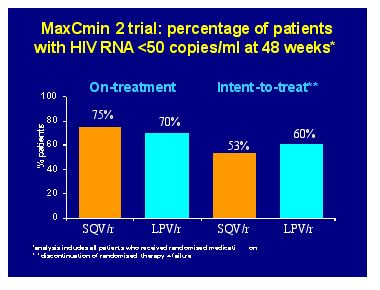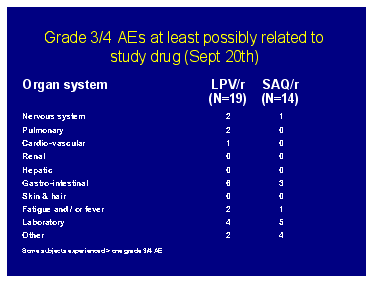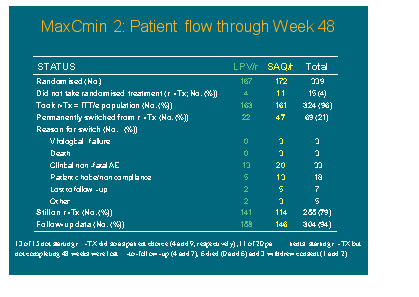 |
 |
 |
| |
MaxCmin 2 study
Reported by Mike Youle, MD, Royal Free Hospital, London, UK
|
| |
| |
In the late breaker poster session there was the first airing of the results of MaxCMin 2 a comparative study of ritonavir boosted saquinavir 1000mg twice daily compared to Kaletra. Since I was the first author for this study presented on behalf of the MaxCmin 2 study team from the Copenhagen HIV programme, Jules has asked me to comment on the results. This study will have an oral presentation with more details later in the year at the European AIDS Clinical Society Meeting in Warsaw. MaxCmin 2 is the second study to compare boosted protease inhibitor combinations in a real life setting across several different clinical groups of patients The primary objective of the trial was to compare the rate of virological failure at 48 weeks for the lopinavir/r (LPV/r) arm relative to the saquinavir/r (SAQ/r) arm. Also, to compare the proportion of patients with HIV-1 RNA < 50 c/ml at week 48, discontinuation of the randomised treatment, and also safety. The trial was randomised (1:1), phase IV, open-label, and multi-centre. Concomitant use of ³ 2 NRTI/NNRTI was decided prior to randomisation. The trial structure is shown below.
Figure 1 |
|
 |
| |
Analyses were intention-to-treat on patients exposed to the randomised treatment (ITT/e (switch included) and ITT/e/switch = failure) and on treatment (OT). All patients, whether discontinued or on the randomised treatment, were followed for 48 weeks. The randomised treatment was initiated in 324/339 (96 %) patients of whom complete follow-up data was available from 304 (94 %). Patients were primarily male (79 %) gay (45 %) and PI-experienced (52 %); 33 % were ART-naive. The risk of protocol-defined virological failure was higher in the SAQ/r arm compared to the LPV/r arm in the ITT/e (p = 0.0009, log rank test) and the ITT/e/s (p = 0.002) analyses, but not in the OT (p = 0.14) analysis. Furthermore, at week 48, 64 % vs. 56 % (ITT/e), 60 % vs. 52 % (ITT/e/s), and 70 % vs. 75 % (OT) in the LPV/r and SAQ/r arm, respectively, had a HIV-RNA < 50 copies/ml (p-value non-significant for all comparisons). Discontinuation of randomised treatment occurred in 69/324 (21 %) patients, 13 % in the LPV/r vs. 29 % in the SAQ/r arm (p = 0.001). In 48 % discontinuation was due to a non-fatal adverse event (AE). No difference in risk of grade 3 and/or 4 AEs was seen between the two arms. In this well balanced but heterogeneous population more patients in the SAQ/r arm experienced protocol-defined virological failure as compared to the LPV/r arm. This difference was not observed in the on-treatment analysis. The clinical toxicity profile was comparable between the two arms, but more patients discontinued SAQ/r due to patients' choice. It is important to note that the soft-gel formulation of saquinavir (Fortovase) was used in this study which is known to be less well tolerated than the hard gel form (Invirase). Some but not all patients swapped from the former to the latter during follow-up but this should be seen as a potential disadvantage to the SAQ/r arm. In addition the pill burden for this arm was 12 a day compared to 6 a day for the LPV/r arm.
Comparing the proportion of subjects who suppressed viral load to <50 copies/ml between this study and the previous MaxCmin 1 study which evaluated boosted saquinavir against indinavir/r 800/100mg twice daily the results are very similar for the SAQ/r arm (Figure 2). That study showed a higher rate of adverse events (particularly renal and skin problems than saquinavir) but in MaxCmin 2 this does not seem to be a major driver for the differences found (i.e. lopinavir and saquinavir seem to be equally well tolerated) (Figure 3).
Figure 2
|
|
 |
 |
| |
Figure 3
The side effect profile in this second study seems to be relatively similar between the two arms with the expected problems of diarrhoea (mainly SAQ/r arm), bloating and nausea (mainly LPV/r arm) predominating. There were five deaths, all in the SAQ/r arm (3 due to HIV related disease, I plane crash and 1 lactic acidosis, presumably driven by the nucleoside backbone). Grade _ events by organ system are shown below and do not differ between arms.
|
|
 |
| |
Figure 4
So what did drive the differences in the ITT analyses? Well it appears that pill burden may have been an issue since there were eleven patients in the SAQ/r arm who opted not to take their randomised treatment versus 4 in the LPV/r arm (Figure 5) In addition 47 subjects in the SAQ/r arm permanently switched to another therapy but only 3 of these were for virological failure (mostly for patient choice or non-compliance).
Figure 5
|
|
| |
 |
| |
Since this was not a blinded study, the issue of pill burden could have played a part in explaining these findings. It is interesting to speculate whether the ITT analyses would be different if the new 500mg formulation of saquinavir had been used in this study. Several trials have shown that pill burden is a major factor in the willingness of patients to take particular regimens and much effort is being put into reducing the burden by making higher concentration formulations or co-formulating drugs such as FTC and tenofovir. It would appear from the data that this was the predominant factor in producing the discrepancy between the intent to treat and on treatment results for this trial. Undoubtedly each drug we have available for HIV has plus and minus points and it is important to define not only what the relative strength of each drug is but also to determine it's real-life utility. Increasingly this will also be related to the wishes of the patient around food, pill burden and potential for uncommon but serious side effects. Further studies are required to ascertain the relative benefits of different boosted protease inhibitor regimens and with the with atazanavir arriving on the market and dual PI regimens being tested our view of how to use these drugs in combination is bound to change over the next few years.
|
|
| |
|
 |
 |
|
|